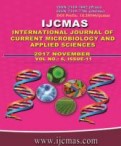


 National Academy of Agricultural Sciences (NAAS)
National Academy of Agricultural Sciences (NAAS)

|
PRINT ISSN : 2319-7692
Online ISSN : 2319-7706 Issues : 12 per year Publisher : Excellent Publishers Email : editorijcmas@gmail.com / submit@ijcmas.com Editor-in-chief: Dr.M.Prakash Index Copernicus ICV 2018: 95.39 NAAS RATING 2020: 5.38 |
A field experiment was conducted at Post Graduate Research Farm, College of Agriculture, Kolhapur during kharif season of 2016 to study the effect of different sources and levels of potassium (K) on yield and quality of kharif groundnut (Arachis hypogaea L.) in Entisol. The experiment was laid out in a factorial randomized block design with two replications in which treatments comprised of five levels of K viz., 0, 10, 20, 30 and 40 kg ha-1 K2O and four sources of K viz., muriate of potash (MOP), sulphate of potash (SOP), bagasse ash and schoenite and 25 and 50 kg ha-1 N and P2O5, respectively, was applied as common basal dose. The results revealed that successive increase in levels of potassium showed significant effect on yield and yield attributes of groundnut crop, along with quality. Significantly highest dry pod, kernel and haulm yields (3169, 2213, and 3894 kg ha-1, respectively) were recorded by application of 40 kg ha-1 K2O, and among the sources, the corresponding highest yields (2770,1926 and 3664 kg ha-1, respectively) were recorded with SOP which were at par with MOP and Schoenite. Significantly highest oil yield was recorded by application of 40 kg/ha K2O (1053.7 kg/ha) and SOP (914.55 kg ha-1) among the levels and sources of K, respectively while interactions were non-significant. Protein content of groundnut kernel was increased from 22% -24.5% with application of 40 kg K2O ha-1 over control and among sources significantly highest protein content was reported with MOP (24.47%) which was superior over all other sources of potassium. The shelling percentage ranged 67-70 % but the effect of various treatments on shelling percentage was non-significant.
 |
 |
 |
 |
 |